Tea towels have evolved far beyond their traditional role as simple kitchen cleaning tools. They now serve as decorative pieces, baking aids, and even table-setting elements. Whether used to dry dishes, wipe surfaces, or add a decorative touch to the kitchen and home environment, tea towels play various roles. Given their diverse uses and frequent contact with different substances, proper cleaning of tea towels becomes essential.

Benefits of Cleaning Tea Towels:
- Extend Lifespan: Regular cleaning prevents the material from deteriorating, thus extending the lifespan of tea towels, whether they are decorative or functional.
- Maintain Hygiene: Kitchen tea towels often come into contact with water, grease, and food residues. If not cleaned regularly, they can become breeding grounds for bacteria. Decorative or dining table tea towels also need to stay clean to maintain their appearance and keep the environment fresh.
- Preserve Aesthetics: Decorative tea towels or those with reactive dye prints need regular cleaning to keep their colors vibrant and patterns intact, preventing dust and dirt from dulling their appearance.
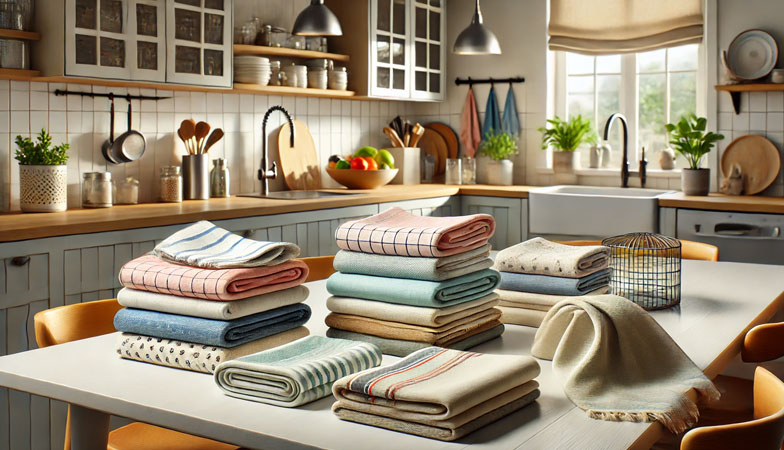
Conversely, if cleaning is neglected, kitchen tea towels may become damp and moldy, reducing their cleaning effectiveness and even posing health risks. Decorative tea towels that accumulate dust or dirt will lose their original beauty and decorative value. Therefore, choosing the appropriate cleaning method for different materials and purposes not only extends the lifespan of tea towels but also ensures they remain in their best condition.

Next, we will explain the cleaning techniques and maintenance methods for different tea towels from two dimensions: material and purpose.
1. Cleaning Methods by Material
The material of the tea towel determines its absorbency, durability, and the ease of cleaning and maintenance. Different materials require different cleaning methods to ensure their longevity and texture.
1. Cotton Tea Towels
Tips: For the first wash, wash separately to avoid color bleeding.
Characteristics: Cotton tea towels are soft and absorbent, making them one of the most common materials for tea towels.
Cleaning Method: Wash with warm water and mild detergent, avoiding bleach. Cotton tea towels can be machine washed using a gentle cycle to prevent shrinking or texture degradation caused by high heat.
Drying Method: It is recommended to air dry naturally or tumble dry on low heat. Avoid direct sunlight to prevent the fabric from becoming stiff.
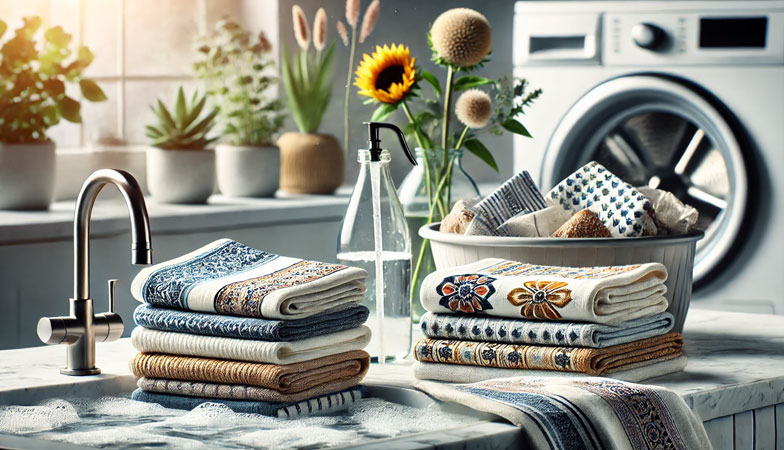
2. Linen Tea Towels
- Characteristics: Linen is highly breathable, dries quickly, and is ideal for wiping glassware without leaving water stains.
- Cleaning Method: Hand washing or using a delicate cycle on a washing machine is recommended. The water temperature should not exceed 30°C (86°F). Use mild detergent and avoid bleach.
- Drying Method: Avoid using a dryer; it’s best to air dry linen tea towels by laying them flat or hanging them, but avoid prolonged exposure to strong sunlight.
- Tips: Linen fibers are relatively delicate, so avoid rubbing them against rough surfaces during washing.

3. Blended Tea Towels
- Characteristics: Blended tea towels made of cotton and linen combine the best of both materials, offering good durability.
- Cleaning Method: You can wash them using the same methods for cotton or linen. When machine washing, use a delicate cycle with warm water to prevent damage to the fibers.
- Drying Method: Air dry naturally or use a low-heat dryer, avoiding high heat settings.
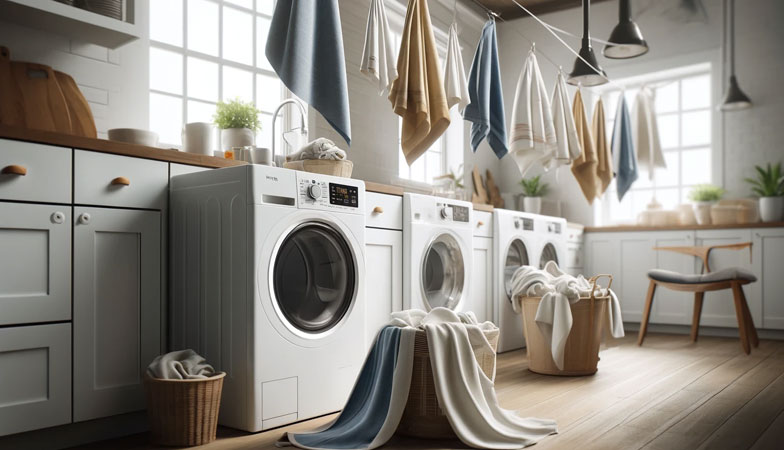
4. Reactive Digital Print Tea Towels
- Characteristics: These tea towels use reactive digital printing technology, resulting in vibrant colors and long-lasting patterns.
- Cleaning Method: Hand wash with cold or warm water, or use a gentle cycle in the washing machine. Avoid washing at high temperatures to preserve the brightness of the colors.
- Drying Method: Air dry naturally and avoid direct sunlight to protect the printed designs.
- Tips: Do not soak the towels for too long, and avoid using bleach or detergents containing bleach.
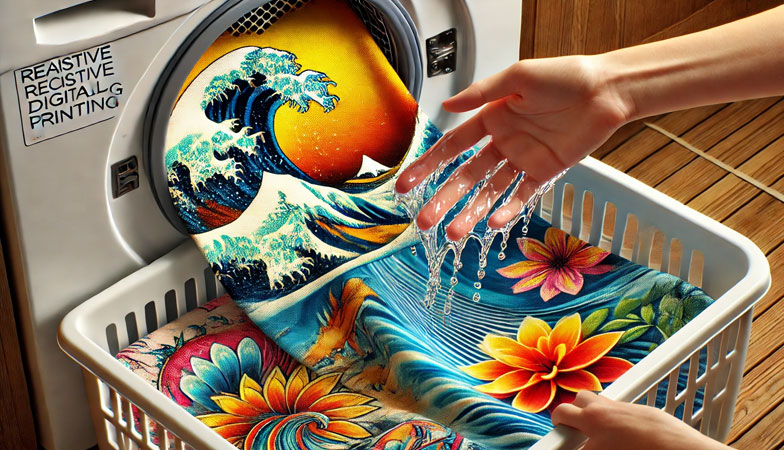
2. Cleaning Methods by Purpose
The purpose of a tea towel determines its frequency of use and the type of substances it comes into contact with. Cleaning frequency and methods vary accordingly.
1. Wiping Tea Towels
- Purpose: Used for drying dishes, and countertops, and frequently comes into contact with water and food residues.
- Cleaning Method: It is recommended to clean daily, using warm water and mild detergent for hand washing or machine washing. A disinfectant can be used weekly for deep cleaning.
- Cleaning Frequency: Clean daily, with regular disinfection.
- Tips: After use, ensure the towel is dried promptly to prevent bacteria growth.
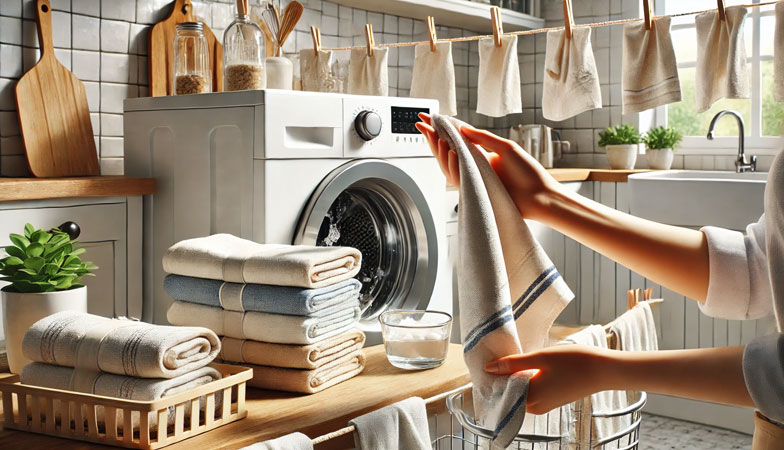
2. Decorative Tea Towels
- Purpose: Primarily used for decoration, with minimal actual usage.
- Cleaning Method: Clean once every two weeks to once a month, using warm water and a delicate machine wash or hand wash. Avoid bleach and harsh detergents.
- Cleaning Frequency: Every two weeks to once a month, adjusted based on the cleanliness of the kitchen environment.
- Tips: To maintain the beauty of the patterns, avoid exposing the towels to direct sunlight after washing.
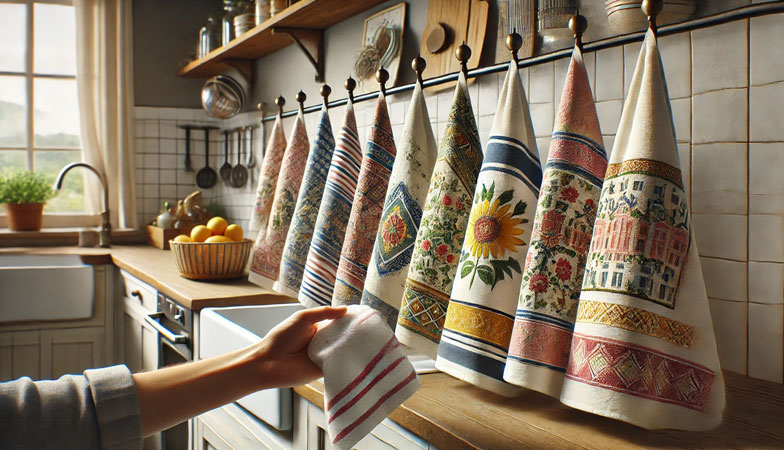
3. Baking Tea Towels
- Purpose: Used for wrapping dough and aiding in fermentation, making direct contact with food.
- Cleaning Method: Clean immediately after each use, using hot water and mild detergent, either by hand or in the washing machine, to ensure thorough cleaning.
- Cleaning Frequency: Must be cleaned after each use and dried properly.
- Tips: Since the towels come into direct contact with food, regular disinfection is recommended to maintain hygiene.

4. Specialized Tea Towels for Wiping Glassware or Stainless Steel
- Purpose: Specifically used for wiping glass or stainless steel surfaces to prevent water spots and residue.
- Cleaning Method: Clean after each use, hand washing or using a gentle machine wash cycle. Avoid using fabric softener, as it may leave residue on the surfaces.
- Cleaning Frequency: Clean after every use to keep the towel free from oil and dirt.
- Tips: Dry the towel immediately after use to prevent moisture from affecting its wiping performance.

The cleaning and maintenance of tea towels not only depend on their material but are also closely related to their actual use. Cotton, linen, blended, and digitally printed tea towels each have different cleaning requirements while wiping, baking, and decorative tea towels require different strategies based on frequency of use and environment. Proper and scientific cleaning and care of tea towels not only extend their lifespan but also maintain kitchen hygiene and aesthetics.

